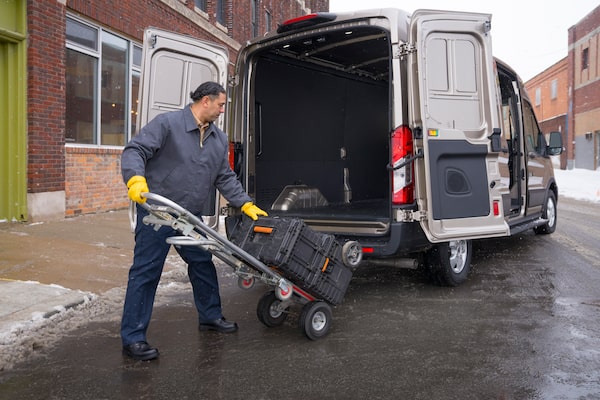
Ford is bringing back the F600 as a 2020 model.Ford
They’re not sexy but they get the job done, and now Ford is doubling down on its lineup of work trucks and vans for 2020.
There’s a new engine, a new drivetrain, boosted connectivity and improved driver assistance across the board. After all, as Ford is quick to point out, if a commercial truck is involved in any kind of collision or incident, it can affect the entire fleet and the company’s bottom line.
Automatic emergency braking will be standard on all 2020 Transit vans and the smaller 2019 Transit Connect vans, and will be offered across the rest of the commercial lineup. Other technologies, including adaptive cruise control, lane departure warning, automatic high beams and driver alert warnings, will also be available in various models.
Every Ford commercial vehicle will come standard with modems for 4G LTE WiFi that allow up to 10 devices to be connected. Ford’s telematics and data services allow fleet managers to see exactly what’s going on with their trucks and vans when they’re out on the road – they can optimize delivery routes and monitor driver behaviour.
The new engine is the 7.3-litre gasoline V8 just introduced in the Super Duty F-Series, which will be available late this year. It finally replaces the 6.8-litre Triton V10 engine that’s been in production for more than 20 years. Engineers won’t say yet how much power and torque it creates, except to say they’ll be greater than the V10’s 288 horsepower and 424 pounds per foot.
The heavier, Medium-Duty trucks – which you might see on the road as snow plows, or hydro bucket trucks, or delivery vehicles – will also be offered with the upgraded, third-generation 6.7-litre diesel engine that’s available with the Super Duty pickups.

The 2020 Ford Transit van will also have an all-wheel-drive option.Ford
This summer, Ford is bringing back the F600 as a 2020 model. It is intended to offer the strength of a larger Class 6 truck, with a gross vehicle weight rating of nearly 10,000 kilograms, but within the physical size of the smaller Class 5 F550. Like the Super Duty pickups and the current F550, it will have a choice of the all-new V8, the upgraded V8 diesel, or the current 6.2-litre gas-powered V8.
It will also have an all-wheel-drive option, as will the 2020 Transit delivery van, driven through the new 10-speed automatic transmission of the Super Duties.
The Transit van is now offered with two new engines for the model: a 3.5-litre PFDi gasoline V6 will be standard, and an optional 2.0-litre bi-turbo four-cylinder diesel, as well as the current 3.5-litre EcoBoost gas engine.
Ford’s new director of fleet, lease and remarketing operations is Mark Buzzell, who was president and chief executive of Ford of Canada throughout 2017 and 2018. His new job is a promotion, because in 2018, Ford’s commercial vehicles held 44 per cent of North America’s market share. “Ford is the undisputed sales leader in commercial vehicles,” he says. “We’ve held this title for 34 straight years. Last year, we sold more commercial vehicles than our four closest competitors combined.”
All those work vehicles are being updated across the board, including the venerable E-Series that’s been in production for almost 60 years. Ford sells it as a cutaway or stripped chassis model that powers vehicles such as ambulances and shuttle buses, and there are more than 2.7 million still on the road.

Every Ford commercial vehicle will come standard with modems for 4G LTE WiFi that allow up to 10 devices to be connected.Ford
They’ll also come standard with more comfortable seats and cabins.
“Major companies have incredibly detailed time and motion analysis of all the repeat operations their drivers have to do,” says Ray Eyles, chief engineer for the Ford Transit. “Things like applying the park brake, putting the transmission into park, then swinging around and walking through to the back.
"Ergonomics are important, because they can make it easier and faster for the driver to be able to swing around from the driver’s seat and walk back to the cargo area, rather than have to struggle to get out of that seat, or exit out the side. If these guys have to stand up from the seat and walk back and do these operations 100 times a day, it’s important for operator safety, and operator health and well-being, that they have the best possible environment to work in. It’s exactly the same as office chairs and office design.”
The writer was a guest of the automaker. Content was not subject to approval.
Shopping for a new car? Check out the new Globe Drive Build and Price Tool to see the latest discounts, rebates and rates on new cars, trucks and SUVs. Click here to get your price.
Stay on top of all our Drive stories. We have a Drive newsletter covering car reviews, innovative new cars and the ups and downs of everyday driving. Sign up for the weekly Drive newsletter, delivered to your inbox for free. Follow us on Instagram, @globedrive.